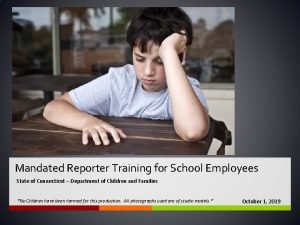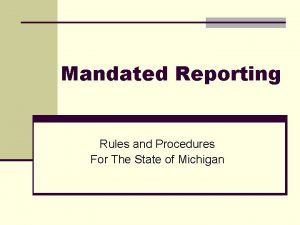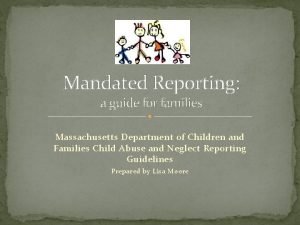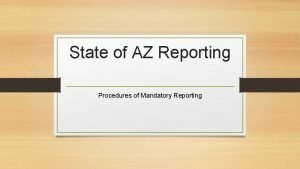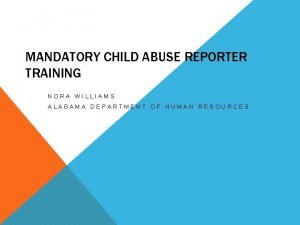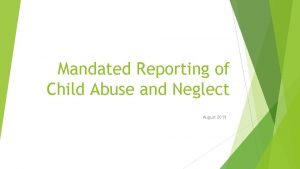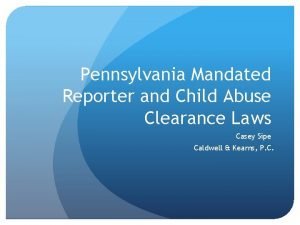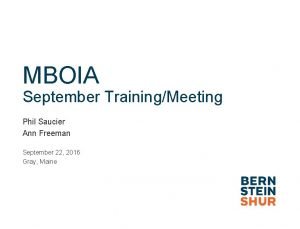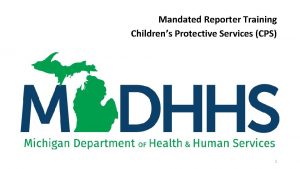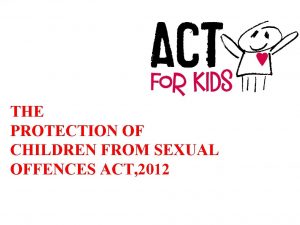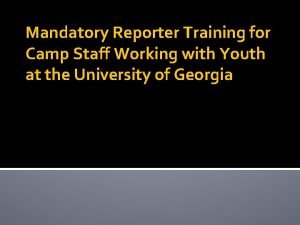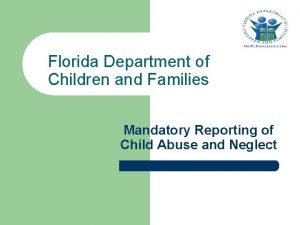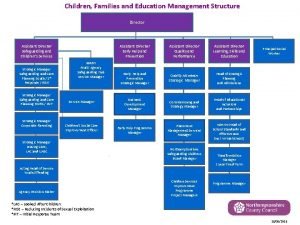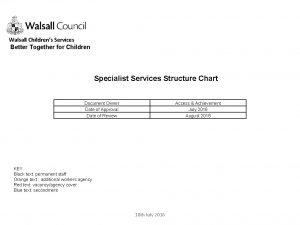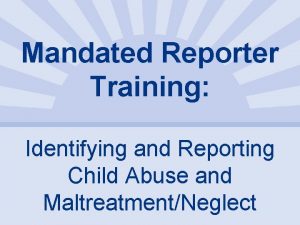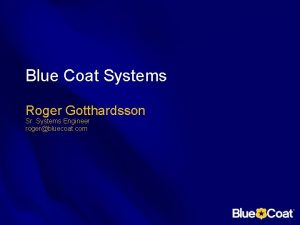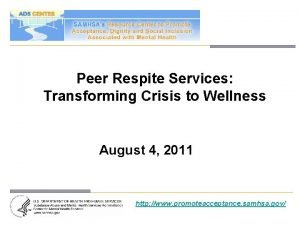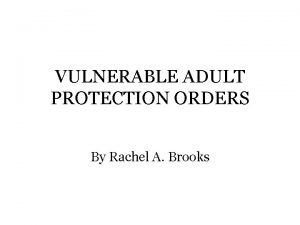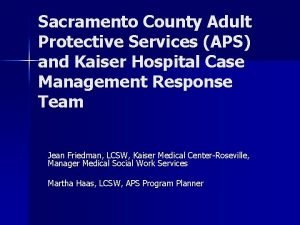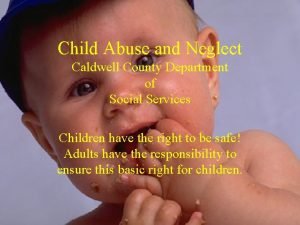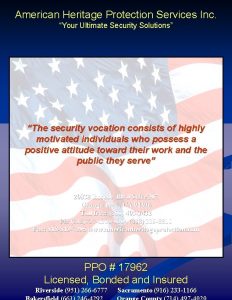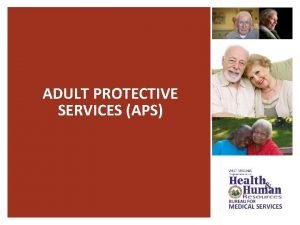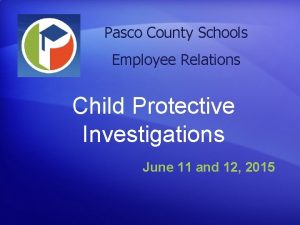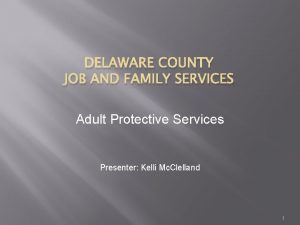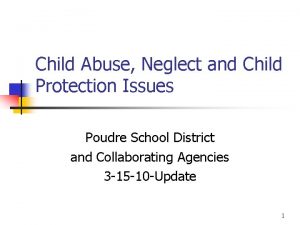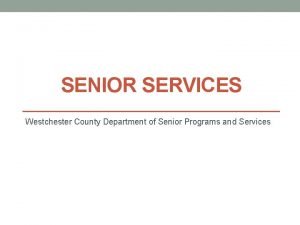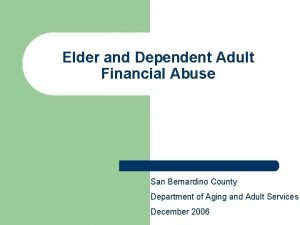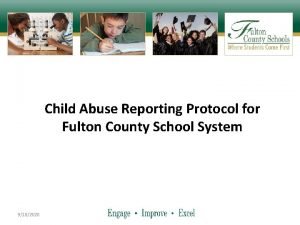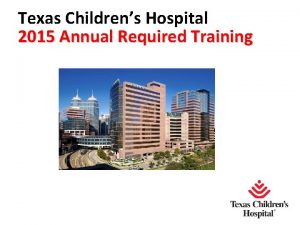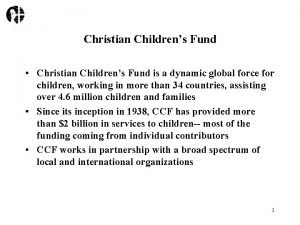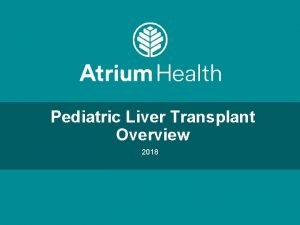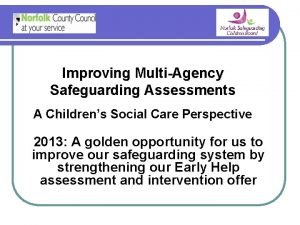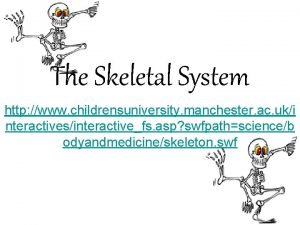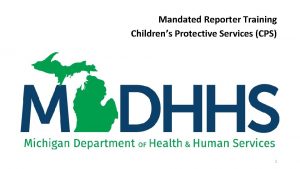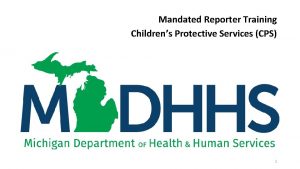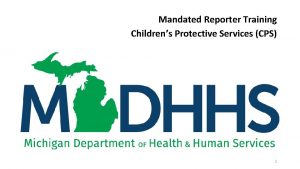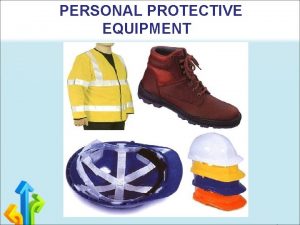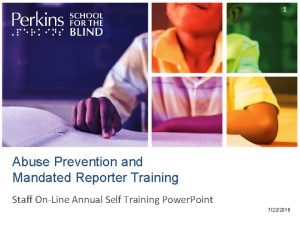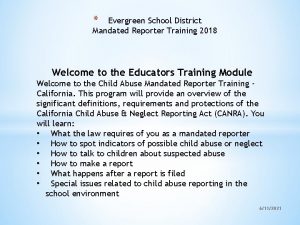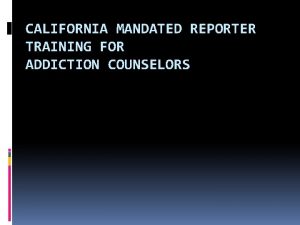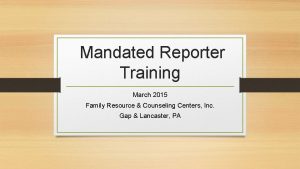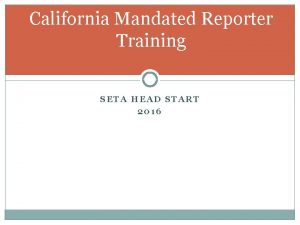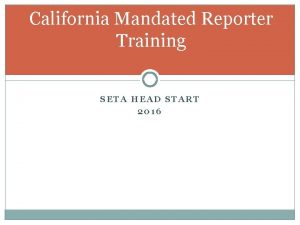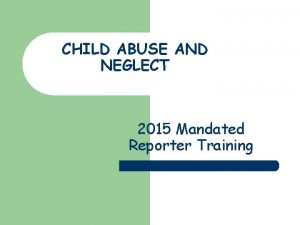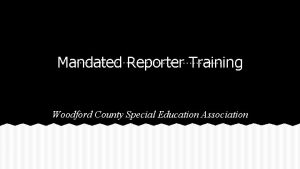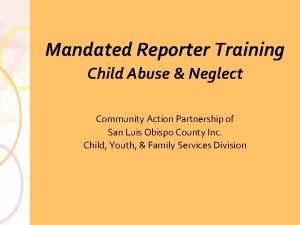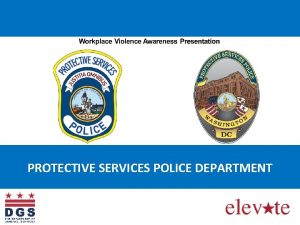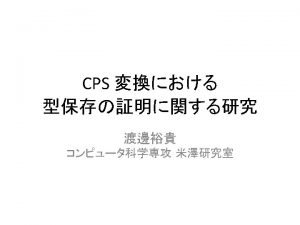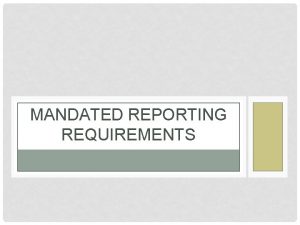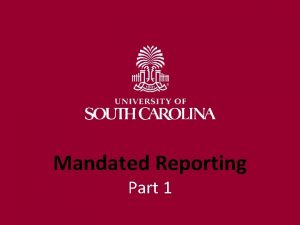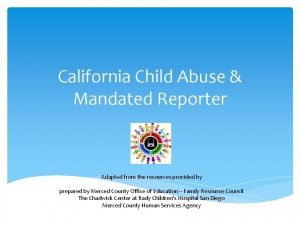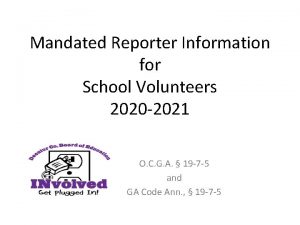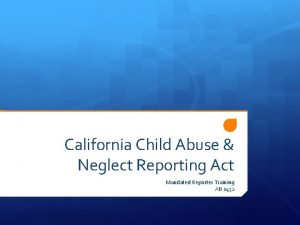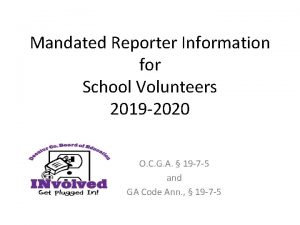Mandated Reporter Training Childrens Protective Services CPS 1







































- Slides: 39

Mandated Reporter Training Children’s Protective Services (CPS) 1

Local Organization Logo Here Name of Local Organization Identifying information for Local Organization Person Facilitating Session 2

Training Objectives After successful completion, trainees will: • Understand mandated reporting. • Know components of the Child Protection Law (CPL). • Recognize certain signs of child abuse and neglect. • Know the MDHHS reporting process. 3

State Law Child Protection Law, 1975 PA 238 The Michigan Child Protection Law, 1975 PA 238, requires the reporting of suspected child abuse and neglect by certain persons (called mandated reporters) and encourages the reporting of suspected child abuse and neglect by all persons. 4

Mandated Reporters People in the following professional roles are required to report suspected child abuse or neglect: • Medical and health care providers • Social workers and counselors • Childcare providers • Clergy and faith leaders • Law enforcement • School administrators and teachers 5

Types of Child Abuse and Neglect • • • Physical abuse Sexual abuse Mental injury Physical neglect Maltreatment 6

State Law: Definition of Child Abuse Harm or threatened harm to a child’s health or welfare that occurs: • By non-accidental physical or mental injury, sexual abuse, sexual exploitation or maltreatment, • To a child under 18 years of age, • By the child’s parent, legal guardian, or other person who is responsible for the child’s health or welfare. 7

Recognizing Physical Abuse Physical abuse is a non-accidental injury. Physical abuse indicators may include: • Bruises § Bruises on an infant are suspicious for abuse. • Burns • Broken bones • Injuries that are patterned, would not occur through normal play, and are symmetric on multiple planes of the body 8

Non. Accidental vs. Accidental Non-Accidental • Parent or other household member hit or shook a child hard enough to cause injury. • Injuries are inconsistent with the explanation provided. • Bruising on an infant may be suspicious for abuse. Accidental • Child was injured during normal child play. • Parent or other household member inadvertently injured the child. 9

An existing pattern of physical or verbal acts and omissions that result in a psychological or emotional injury. Recognizing Mental Injury 10

Signs can include: § Depression, anxiety or suicide. § Lack of attachment. § Fear of abandonment or safety. Recognizing Mental Injury § Fear that life or safety is threatened. The parent or caretaker may: § Constantly criticize, punish or demean the child. § These behaviors are persistent and repetitive. *A finding must be made by a mental health professional. 11

Intentional touching/contact that can be reasonably construed as being for the purpose of arousal, gratification or any other improper purpose by the perpetrator. Recognizing Sexual Abuse or Sexual Exploitation Sexual penetration. Accosting, soliciting or enticing to commit, or attempt to commit an act of sexual contact or penetration, including prostitution. Sexual abuse may not always involve sexual penetration. 12

Indicators: Physical evidence (genital bruising, presence of semen, etc. ). Pregnancy or contracting a venereal disease, especially in children 12 years or younger (requires a report to CPS). Recognizing Sexual Abuse Self-reports sexual abuse. Inappropriate sexualized behavior, outside of normal exploration relevant to age and development. Sudden change in behavior, isolated or secretive. Running away. 13

Human Trafficking Sex Trafficking Labor Trafficking • Subjecting an individual to the recruitment, harboring, transportation, provision, patronizing, or soliciting for the purposes of a commercial sex act or trafficking an individual for a commercial sex act induced by force, fraud, or coercion. • A person recruited, enticed, harbored, transported, provided, or obtained for the purposes of labor or services. • Can include domestic servitude, force labor in restaurants or salons, forced agricultural labor or debt bondage. 14

Sexually transmitted diseases Symptoms of post-traumatic stress Human Trafficking Indicators Malnourished or always hungry Signs of physical and/or sexual abuse, physical restraint, confinement or torture Victims and perpetrators are often skilled at concealing their situations Live with other unrelated youth and with unrelated adults Not in control of their own identification documents 15

Recognizing Maltreatment Child maltreatment is the treatment of a child that involves cruelty or suffering that a reasonable person would recognize as excessive. Examples may include: • Medical child abuse. • Age inappropriate chores. • Treating a child like an animal: eating pet food from an animal food bowl. • Parent publicly announcing about a child who is bedwetting (humiliation). • Inappropriate expectations based on the child’s capability. 16

Harm or threatened harm to a child’s health or welfare that occurs through: State Law: Definition of Child Neglect • Negligent treatment, including the failure to provide adequate food, clothing, shelter, or medical care. • Placing the child at an unreasonable risk to the child’s health or welfare by failure of the parent, legal guardian, or other person responsible for the child’s health or welfare to intervene to eliminate that risk when the person is able to do so and has, or should have, knowledge of the risk. *Does not include the inability of a parent to feed, clothe or house a child because they lack resources or supports. 17

Recognizing Neglect • Suffers from chronic dental and/or medical issues that are not being addressed. • Filthy/unhygienic or inadequately clothed on multiple occasions. • Self-reports no one is home and does not demonstrate the ability to care for themselves. • Frequent absence from school. • Steals or begs for food or money repeatedly. 18

Concerns That Do Not Involve Neglect There are certain situations that do not require calling in a complaint to CPS: • Children who are unattended in a situation where the child(ren)’s age, development and circumstances do not indicate a likelihood of harm. • A parent or caretaker’s use of substances that does not affect their ability to care for their child. • A parent or caretaker’s mental illness that does not affect their ability to care for their child. • A parent does not comply with their court-ordered treatment plan. 19

Substance Use Concerns • Mandated Reporters must call CPS when: o They know, typically through testing of the newborn, that the newborn has a substance in their body or, o The newborn displays symptoms indicating they have a substance in their body. • This does not include controlled substances or metabolites, used for medication assisted treatment, medical marijuana or medication prescribed to the mother or the newborn. 20

Head lice What is NOT investigated? Issues attributed to poverty Educational concerns Sibling on sibling abuse 21

Disproportionality • Disproportionality is the over or under representation of a certain group of people. • Child abuse or neglect exists in every racial and ethnic group, culture, economic class, and every cross section of our society. • Cultural differences do not always equate to abuse or neglect. • Ask yourself: ü Would I make the same call in the same way if I saw things in the same family that reminded me of my own? 22

Communities Protecting Children • Protective approaches can make meaningful differences in parenting skills and child well-being. Research has shown that these approaches help strengthen families. • Prevention efforts can be made prior to reaching CPS involvement. • Referring families to available resources may help mitigate risk, if concerns do not rise to the level of abuse or neglect. • If you know of resources available that may help a family, provide them with that information. 23

Prevention The Children’s Trust Fund serves as a voice for Michigan’s children and families and promotes their health, safety and welfare by funding effective local programs and services that prevent child abuse and neglect. Learn more at www. Michigan. gov/ctf or by calling 517 -373 -4320 24

Goals of CPS • The goal of CPS is to keep children safe in their homes and to provide them with a safe environment when they are determined to be unsafe. • CPS strives to keep children in their own homes when safe to do so and parent’s participation through this process is key. • Most parents want to appropriately care for their children. They have the strength to do so when supported by family or social networks in caring for their children and keeping them safe. • CPS must support families and provide them with the tools they need to be successful. 25

Move the child to a private area How to Respond When A Child Tells You Something Happened Abuse or Neglect Maintain eye contact Use a soothing and supportive stance and tone Do not display any signs of shock Do not display signs of disapproval Ask open ended questions (“how” and “what”) After speaking with the child, take detailed notes about the conversation 26

Reporting Concerns “I don’t want to interfere in someone’s family. ” • You may be the only person to intervene and ensure a child’s safety. 27

Ways to Report • Immediate report to MDHHS v 855 -444 -3911 o Be prepared to give as much demographic information as possible o Providing the family’s address is essential o Provide detailed information including statements in quotations v Michigan Online Reporting System (MORS) o State of Michigan employees: Mi. Login o Outside entities: Michigan. gov/mandatedreporter • Must select link and register. • Written report (DHS-3200) within 72 hours o A DHS-3200 is not required, if utilizing MORS o Only mandated reporters are required to follow up with a DHS-3200 • Notify the head of your organization if required by your employer. 28

Detailed Reporting Requirements Child Protection Law requires a detailed report: • “The report shall contain other information available to the reporting person that might establish the cause of the child abuse or child neglect, and the manner in which the child abuse or child neglect occurred. ” • This “other information available to the reporting person” includes details known about the child, family and the specific situation. Please explain the who, what, where, when, why and how. • Complaints should still be made if not all the information is known; however, as much information that is known, must be provided. 29

Provide as much detail as possible when making a report A detailed report would be as follows: “On 05/01/2019, Johnny reported his mother hit him four times on the right elbow with a wooden spoon. The incident happened in Johnny’s bedroom. On 05/02/2019, Johnny had a large, circular, dark purple bruise on his inner right elbow. Johnny is afraid to go home because he fears being hit. ” You can also utilize the Guide to Detailed Reporting found on the MDHHS Mandated Reporters website. 30

State Law Protections for Reporters Immunity Protection • A person making a report is presumed to have acted in good faith and is immune from civil or criminal liability. • This does not extend to a negligent act that causes personal injury or death. Confidentiality Protection • The identity of the referral source is kept confidential without: • Consent of the reporter • Judicial order 31

State Law Penalties for Not Reporting State Law Penalties for False Reporting • Criminal penalties • 93 days in jail, or • A fine not more than $500, or • Both • If the child abuse or neglect reported would not constitute a crime or would constitute as a misdemeanor, if the report were true: • 93 days in jail, or • A fine of not more than $100, or • Both • Civil penalties • Liable for injuries • Liable for future loss/damages • If the child abuse or neglect reported would constitute a felony, if the report were true is punishable by the lesser of the following: • The penalty for the child abuse or neglect falsely reported. • Imprisonment for not more than 4 years, or a fine of not more than $5000, or both. 32

Reporting: Centralized Intake will gather the following from the reporter: • Name of the child, parents, and/or legal guardians. • Description of suspected abuse or neglect. • Any information that might establish the cause of suspected abuse or neglect. • Who, what, when, where, why and how. • Your contact information. 33

Reporting DHS-3200 Form § Go to http: //michigan. gov/dhhs. § Click on “Abuse and Neglect” tab in the middle of screen. § On right side of screen, click on the PDF that corresponds with the DHS 3200. 34

Next Steps for CPS Notification process for mandated reporters includes: • If the report IS investigated, you will receive a letter from the appropriate MDHHS county office following the investigation. CPS is no longer required to contact the mandated reporter for additional information; however, the investigator may do so if necessary. 35

• Complaint will be reviewed for assignment. • If assigned, a caseworker begins an investigation within 24 hours. • An investigation is normally completed within 30 days. • Services may be offered to the family. • Protecting interventions may be necessary. • CPS will keep your information confidential. v. Per the CPL, your identifying information will not be shared unless court ordered. Next Steps for CPS 36

Investigating Next Steps for CPS • CPS will interview children, adults, neighbors, family, professional staff, etc. • CPS will coordinate with law enforcement in certain investigations. • Approximately 85% of investigations are not confirmed. • MDHHS will inform mandated reporters in writing as to the result of the investigation. 37

Outcomes of CPS Investigations Category V • No services recommended – Following a field investigation, CPS determines there was no evidence of child abuse or neglect. Category IV • Community services recommended – Though child abuse or neglect was not confirmed, community services are recommended by CPS. Category III • Community services are needed– A preponderance of evidence supports child abuse or neglect occurred. The risk assessment (structured-decision making tool) indicates low or moderate risk of future harm to the child(ren). Category II • Services are required to maintain the child safely in the caretaker’s home– A preponderance of evidence supports child abuse or neglect occurred. The risk assessment suggests high or intensive risk of future harm to the child(ren). MDHHS and community services are needed. Category I • A court petition is filed– A preponderance of evidence supports child abuse or neglect occurred and the law requires a court petition, court ordered services are needed to keep the child(ren) safe in the caretaker’s home, or a child is unsafe in the caretaker’s home. 38

Additional Information Mandated Reporter resources are available online at: www. michigan. gov/mandatedreporter 39
 Mandated reporter training ct
Mandated reporter training ct Mandated reporter laws
Mandated reporter laws Mandated reporter massachusetts
Mandated reporter massachusetts Mandatory reporting procedures
Mandatory reporting procedures Mandatory reporting alabama
Mandatory reporting alabama Mandated reporter louisiana
Mandated reporter louisiana Pa child abuse
Pa child abuse Is dr phil a mandated reporter
Is dr phil a mandated reporter Michigan cps 3200
Michigan cps 3200 Mandated reporter definition
Mandated reporter definition Are camp counselors mandated reporters
Are camp counselors mandated reporters Mandated reporter florida
Mandated reporter florida Childrens services
Childrens services Childrens services walsall
Childrens services walsall Normal bruising areas on a child
Normal bruising areas on a child Blue coat reporter training
Blue coat reporter training Georgia mental health consumer network cps training
Georgia mental health consumer network cps training Rachel brooks attorney vancouver wa
Rachel brooks attorney vancouver wa Sacramento adult protective services
Sacramento adult protective services Caldwell county department of social services
Caldwell county department of social services Dfw protective force
Dfw protective force American heritage protective services inc
American heritage protective services inc Wv aps
Wv aps Pasco child protective services
Pasco child protective services Integrated protective services
Integrated protective services Delaware county adult protective services
Delaware county adult protective services Crs 19-3-304
Crs 19-3-304 Westchester county senior services
Westchester county senior services Lorain county children services
Lorain county children services Aps san bernardino county
Aps san bernardino county Georgia dfcs investigation protocol
Georgia dfcs investigation protocol Rowan county medicaid transportation
Rowan county medicaid transportation Texas children's hospital moli
Texas children's hospital moli The christian childrens fund
The christian childrens fund Levine childrens
Levine childrens National sovereignty and childrens day
National sovereignty and childrens day Kirklees safeguarding childrens board
Kirklees safeguarding childrens board World book day quiz
World book day quiz Childrens university of manchester
Childrens university of manchester Longman children's picture dictionary
Longman children's picture dictionary
